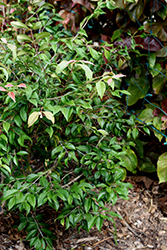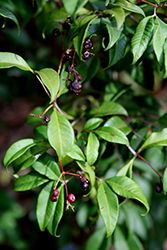It's all about ...
plants

Height: 15 feet
Spread: 10 feet
Sunlight:
![]()
![]()
Hardiness Zone: 10a
Other Names: Pale Lidflower, syn. Myrcia neopallens
Description:
An upright shrub or small tree with a spicy fragrance that gives it its name; small, green glossy leaves emerge with a red tinge; inconspicuous white flowers in spring and summer have a nice fragrance; orange-red fruits are appealing to birds
Ornamental Features
Spicewood is primarily grown for its highly ornamental fruit. It features an abundance of magnificent red berries with yellow hints from late summer to early winter, which fade to black over time. It has attractive light green-variegated forest green foliage with hints of chartreuse which emerges rose in spring. The glossy oval pinnately compound leaves are highly ornamental and remain forest green throughout the winter. It features subtle clusters of fragrant white flowers at the ends of the branches from early spring to early fall.
Landscape Attributes
Spicewood is a multi-stemmed evergreen shrub with a shapely oval form. Its average texture blends into the landscape, but can be balanced by one or two finer or coarser trees or shrubs for an effective composition.
This is a relatively low maintenance shrub, and should only be pruned in summer after the leaves have fully developed, as it may 'bleed' sap if pruned in late winter or early spring. It is a good choice for attracting birds, bees and butterflies to your yard. It has no significant negative characteristics.
Spicewood is recommended for the following landscape applications;
- Accent
- Mass Planting
- Hedges/Screening
- General Garden Use
- Container Planting
Planting & Growing
Spicewood will grow to be about 15 feet tall at maturity, with a spread of 10 feet. It has a low canopy, and is suitable for planting under power lines. It grows at a medium rate, and under ideal conditions can be expected to live for approximately 25 years.
This shrub does best in full sun to partial shade. It is quite adaptable, prefering to grow in average to wet conditions, and will even tolerate some standing water. This plant will benefit from an application of bonemeal and/or mycorrhizal fertilizer at the time of planting. It is not particular as to soil pH, but grows best in sandy soils, and is able to handle environmental salt. It is highly tolerant of urban pollution and will even thrive in inner city environments. This species is native to parts of North America.
Spicewood makes a fine choice for the outdoor landscape, but it is also well-suited for use in outdoor pots and containers. Because of its height, it is often used as a 'thriller' in the 'spiller-thriller-filler' container combination; plant it near the center of the pot, surrounded by smaller plants and those that spill over the edges. It is even sizeable enough that it can be grown alone in a suitable container. Note that when grown in a container, it may not perform exactly as indicated on the tag - this is to be expected. Also note that when growing plants in outdoor containers and baskets, they may require more frequent waterings than they would in the yard or garden. Be aware that in our climate, most plants cannot be expected to survive the winter if left in containers outdoors, and this plant is no exception. Contact our experts for more information on how to protect it over the winter months.
This plant is not reliably hardy in our region, and certain restrictions may apply; contact the store for more information.

